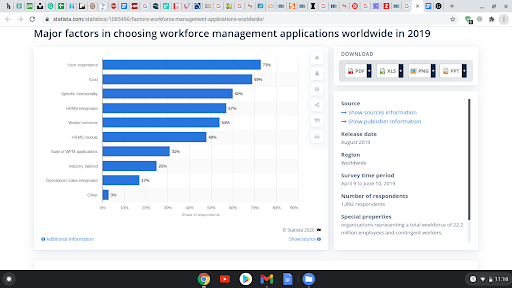9 Effective Measures to Artfully Manage Your Workforce
Running a successful business comes with a whole boatload of responsibilities- one of which entails managing your workforce.
Yes, it's true that your employees are your biggest assets. Hiring the best team members gives you a considerable competitive advantage, placing your business ahead of the crowd.
But employees can make or break your business. Mismanagement on your behalf can unravel years of hard work.
The key is to know how to manage your workforce effectively.
At first glance, it may seem challenging. But with the right plan and strategies, you can make a significant impact.
To help you get started in the right direction, here are some workforce management tips that can help you maximize your employees' competency and performance.
1. Create a plan
You understand the needs of your business better than anyone else. But this requires making plans to ensure your company grows and thrives.
Research suggests that an effective workforce planning strategy makes businesses nearly 66% more successful than their competitors. It helps boost the performance levels of employees without increasing resources. In other words, you're aiming for greater productivity without the added cost.
Workforce planning begins with setting realistic, well-defined goals and identifying the right skill set needed to achieve the required results. To improve teamwork and collaboration, state your goals clearly so that everyone aligns with the organization's mission.
Also, consider devising a flexible plan that allows your business to adapt to changes in market forces, new opportunities, or financial constraints. More importantly, you need to develop practical solutions depending on the experience, skills, and knowledge of your employees.
2. Hire the right team players
As a manager, you know goals and objectives aren't enough. You need the backing of competent, dedicated professionals that will collaborate and take your company to greater heights. But that means recognizing essential talents and skills when recruiting employees.
Employing the right people with the right skill set will enhance profitability and growth. However, to ensure your workforce reaches its full potential, you need to look at the company's long-term interests.
More than a third of global executives said they are unequipped to address the skill gap, reports a study by McKinsey. But the challenge is more real for the 60% of businesses that claim half their current workforce will need to be either retrained or replaced within the next five years.
As a manager, you need to plan for where you want your company to be. That begins by analyzing the current workforce and aligning them with your business's needs while also identifying the future requirements of both your organization and the workforce. More importantly, by recognizing the gaps between these two aspects, you can effectively prepare and plan for your company's growth.

3. Implement better communication practices
Effective communication is the core component of success. It allows you to pass information to other people so that they know exactly what is expected of them. But more than that, it requires the capability to listen actively. Therefore, good communication skills help build trust, maintain a positive work environment, and allow you to understand your employees better.
Unfortunately, communication is an issue in many organizations. According to the statistics, 57% of employees report not being given clear directions, while 69% of managers aren't comfortable communicating with their employees.
As a manager, you must have the ability to communicate accurately and clearly. However, good communication encompasses both verbal and written skills. While planning and organizing various aspects of the business are vital processes, it will all be for nothing if your employees are unable to understand what you want them to achieve.
More importantly, communication between departments is essential for fostering collaboration. The 2018 State of Workforce Management Survey pinpointed that 66% of organizations struggle with communication between departments. Executives need to make it easy for departments to interact with each other. Often, it involves removing information silos and promoting the accessibility of data in real-time.
4. Develop a positive environment
One of the biggest challenges of workforce management is developing and maintaining a positive work environment. By creating holistic well-being and an overall sense of happiness, you can eliminate stress and negativity. Moreover, research shows it can boost employee productivity by nearly 12%. Happy employees perform better, work more efficiently, achieve goals, are more self-motivated, and often exceed expectations.
As a manager, you can promote a positive environment by:
- Prioritizing onboarding and training processes
- Encouraging communication by asking for feedback
- Motivating employees
- Being direct but kind with recommendations
- Spreading overall cheer
- Conducting regular check-ins
- Recognizing and appreciating work done right

5. Reward good performance
Everyone likes being valued, and your employees are no different. A survey conducted by Forbes stated that appreciation is one of the most cost-effective techniques for improving employee morale. More importantly, it makes employees feel valued. 69% say they would work harder if better appreciated.
Though a simple thank you or shout-out can suffice, you want to build strong, long-term relationships. Consider offering something that serves as a reminder of their achievement while motivating others to do the same, such as merit-based rewards or bonuses.
6. Create staff schedules
Workforce management demands adherence to schedules. Not only does this keep the company organized, but it helps employees plan their lives outside of work. The clarity in schedules provides the freedom to swap shifts with peers or request vacation time.
For managers, sound employee scheduling systems can:
- Help manage employee shifts
- Allow schedules to be made months in advance yet enable tweaks to be made easily
- Ensure smooth and efficient operations within the company
- Improve productivity and reduce labor costs
- Track the number of hours a worker is putting into the job
- Facilitate labor forecasting efforts to prevent understaffing or overstaffing
7. Invest in the right technology
Thanks to technological advancements, it is getting increasingly easier for executives to manage the workforce. But that relies significantly on choosing the right tools. According to the 2018 State of Workforce Management report, a mere 19% of executives are satisfied with the digital tools currently being used in their organization.
This leaves a lot of room for improvement. Considering there is a whole range of software that you can use to enhance your management skills, begin by identifying areas that can improve by streamlining activities. Studies indicate that there is growing adoption of cloud-based workforce management solutions across all verticals.
For instance:
- HR software can facilitate the hiring process.
- Remote technologies can offer flexibility, allowing employees to work from any location and access data in real-time.
- Communication technologies provide seamless connectivity and keep everyone in the loop.
- Employee scheduling software can help managers effortlessly schedule staff shifts, track work hours, process payrolls, etc.
- Task management software smoothens the flow of work processes and allows employees to complete goals efficiently.
In order to find the perfect tool that aligns with your business's goals, you need to consider incorporating those that are user-friendly, have a record of being successful, and can be easily integrated into your current tech stack. Factors that executives focus on include:

Popular tools include ProofHub, Slack, Trello, ShiftNote, and Zoom.
8. Review management processes
As a manager, your goal is to increase productivity across the entire organization. That's a tough job. However, measuring the outcomes of your strategies is an excellent way of understanding whether your techniques are on target or not. Moreover, it gives you a chance to rectify methods so that they produce optimum results.
Another way to review current policies is to get employee feedback. Employee engagement surveys and suggestions can help provide insight into areas that need to be looked into. Listening to employees and implementing regular employee feedback campaigns can help lower staff turnover by 4.9%.
9. Prepare for change
COVID-19 has taught us all a very important lesson- be prepared. In order for your organization to adapt to unique situations, you need to formulate flexible working strategies. Preparing an agile workforce that is ready to continue working no matter what the demands of the marketplace can help you scale at times when others are struggling.
Flexibility is becoming increasingly important. Companies around the world are embracing change to keep their businesses viable in the competitive economic climate.
Under the current pandemic conditions, most employees are working from home. And that means being able to manage work processes remotely. Utilizing the right digital technologies is helping people balance tasks from the office alongside household responsibilities. But generally speaking, by incorporating flexible working strategies, you can improve employee retention rates, reduce overhead costs, and boost productivity.
Final thoughts
Management is a crucial aspect of a successful business. It builds a cohesive bond between employees, bolstering collaboration, increasing productivity, and reducing costs.
But more than that, you need to become a leader. And that entails boosting morale and trust among your workforce. By looking at the bigger picture and thinking of your company's future, you can plan for improvements, including employee training workshops, incorporation of emerging technologies, expansion of products or services, and much more.
It's time to take your management skills to the next level.


